
Slime mold or slime mould is an informal name given to several kinds of unrelated eukaryotic organisms with a life cycle that includes a free-living single-celled stage and the formation of spores. Spores are often produced in macroscopic multicellular or multinucleate fruiting bodies which may be formed through aggregation or fusion. Slime molds were formerly classified as fungi but are no longer considered part of that kingdom. Although not forming a single monophyletic clade, they are grouped within the paraphyletic group Protista.

Stemonitis is a distinctive genus of slime moulds found throughout the world. They are characterised by the tall brown sporangia, supported on slender stalks, which grow in clusters on rotting wood. The genus was first described by German botanist Johann Gottlieb Gleditsch in 1753. A 2014 estimate suggests that there are 18 species in the genus. Identification within the genus is difficult, and can only be performed with confidence using a microscope or by DNA sequencing. A fossil specimen is known from the mid-Cretaceous.
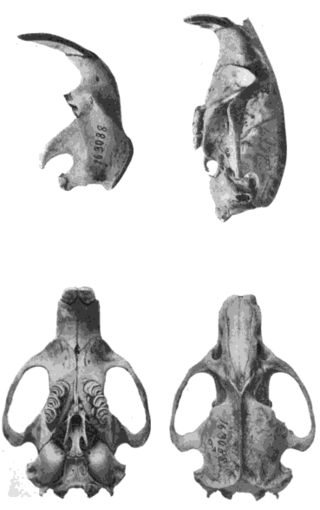
The King African mole-rat, King mole-rat, or Alpine mole-rat, is a burrowing rodent in the genus Tachyoryctes of family Spalacidae. It only occurs high on Mount Kenya, where it is common. Originally described as a separate species related to Aberdare Mountains African mole-rat, in 1910, some classify it as the same species as the East African mole-rat,.

Myxogastria/Myxogastrea or Myxomycetes (ICN), is a class of slime molds that contains 5 orders, 14 families, 62 genera, and 888 species. They are colloquially known as the plasmodial or acellular slime moulds.

Hibiscus splendens, the splendid hibiscus, is a species of flowering shrub or tree in the mallow family, Malvaceae. Other common names include hollyhock tree and pink cottonwood. H. splendens is a fairly common plant native to eastern Australia. The range of natural distribution is from Wollongong in the state of New South Wales to Blackdown Tableland National Park in central east Queensland. The habitat is on clearings or disturbances around the margins of the drier rainforests.

Stemonitis fusca is a species of slime mold. It fruits in clusters on dead wood and has distinctive tall brown sporangia supported on slender stalks with a total height of approximately 6–20 mm tall.

Brefeldia maxima is a species of non-parasitic plasmodial slime mold, and a member of the class Myxomycetes. It is commonly known as the tapioca slime mold because of its peculiar pure white, tapioca pudding-like appearance. A common species with a worldwide distribution, particularly in North America and Europe. It is often found on bark after heavy rain or excessive watering. Their spores are produced on or in aerial sporangia and are spread by wind, however beetles of the family Latridiidae are also reported to disperse the spores. Bonner states that soil invertebrates and rain mainly disperse spores as they are sticky and unlikely to be carried by air currents.
Bulbophyllum nocturnum is a species of epiphytic orchid that grows in New Britain. It was described in 2011, and is the first species of orchid known to consistently flower during the night, and close its flowers during the day.
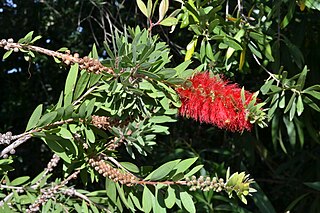
Melaleuca citrina, the common red bottlebrush, crimson bottlebrush, or lemon bottlebrush, is a plant in the myrtle family Myrtaceae, and is endemic to eastern Australia. Some Australian state herbaria continue to use the name Callistemon citrinus. It is a hardy and adaptable species, common in its natural habitat. It is widely cultivated, not only in Australia. It was one of the first Australian plants to be grown outside the country, having been taken to England in 1770 by Joseph Banks. Its showy red flower spikes, present over most of the year in an ideal situation, account for its popularity.

Trichia decipiens is a worldwide widespread slime mould species from the order Trichiida.

Lindbladia tubulina is a slime mould species from the order Liceida and the only member of its genus.
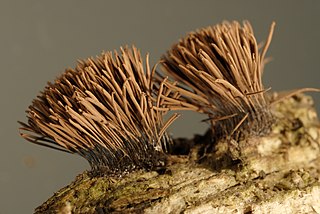
Stemonitis axifera is a species of slime mold. It fruits in clusters on dead wood, and has distinctive tall reddish-brown sporangia, supported on slender stalks.
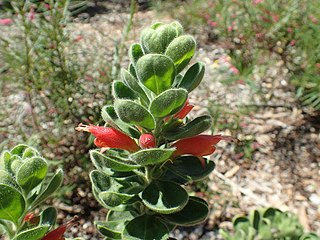
Eremophila splendens is a flowering plant in the figwort family, Scrophulariaceae and is endemic to Western Australia. It is a shrub which is mostly covered with a layer of glandular hairs and has red, unspotted flowers.

Acacia splendens is a tree or shrub of the genus Acacia and the subgenus Phyllodineae that is endemic to a small area of western Australia.

Eucalyptus arcana, commonly known as the Mallee manna gum or Carpenter Rocks gum is a mallee that is endemic to South Australia. It has rough bark from the base of the trunk to the thinnest branches, lance-shaped, sometimes curved leaves, flower buds in groups of seven, white flowers and hemispherical fruit. It is only known from a single population near Carpenter Rocks.
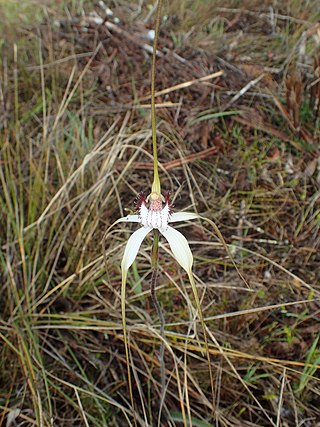
Caladenia splendens, commonly known as the splendid spider orchid, or splendid white spider orchid is a species of orchid endemic to the south-west of Western Australia. It has a single erect, hairy leaf and up to three mostly white flowers with a fringe of long teeth on the sides of the labellum. Along with the giant spider orchid, Caladenia excelsa it is the largest of the spider orchids.
Eucalyptus splendens, commonly known as apple jack, is a species of small, spreading tree that is endemic to a small area of Victoria, Australia. It has fibrous or corky bark on the trunk and thicker branches, lance-shaped to curved adult leaves, flower buds in groups of seven, white flowers and hemispherical to cup-shaped fruit.

Euryopis splendens is a species of comb-footed spider in the family Theridiidae. The range of distribution is the south east of Australia. The spider lives under stones or bark.

Prostanthera splendens is a species of flowering plant in the family Lamiaceae and is endemic to Western Australia. It is a small, spreading shrub with small, densely glandular, egg-shaped leaves and mauve to light purple flowers, paler on the inside with mauve to reddish-brown dots.


















